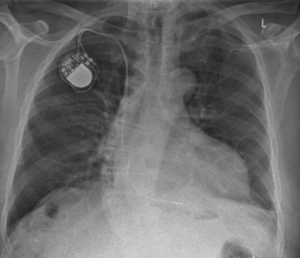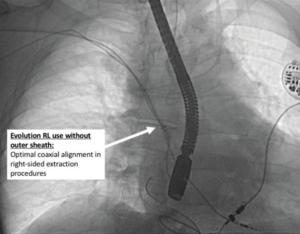By Prof Dr Christoph T Starck, FEHRA This advertorial was sponsored by Cook Medical
We report the case of a 74-year old-male patient with a cutaneous device perforation due to a pocket infection of a dual chamber pacemaker system. Eleven years ago the patient received the right-sided dual chamber pacemaker implantation due to third degree AV block. Four years ago a device exchange was performed due to battery depletion. The patient was referred to our centre for complete device removal.

On admission routine preoperative diagnostics for lead extraction patients were carried out. In echocardiography large lead vegetations were ruled out. Pre-operative chest X-ray showed an active fixation right atrial and right ventricular lead with lead-leadinteractions in the area of the superior vena cava (Figure 1). Device interrogation showed that the patient was pacemaker dependent with an insufficient spontaneous rate. Intracardiac electrogram of the right-atrial lead revealed atrial fibrillation at the present interrogation.
After routine pre-operative preparation and with informed consent the patient underwent explantation of the right-sided dual chamber pacemaker and implantation of an epicardial right ventricular lead via a subxiphoidal approach. The epicardial lead was connected to a dual chamber pacemaker placed in a subcutaneous device pocket in the left subclavicular region to allow for transvenous implantation of a right atrial lead in the further course if needed due to intermittent recovery of sinus rhythm. The procedure was performed under general anaesthesia, in stand-by of extracorporeal circulation and in a hybrid operating room. Despite extensive fibrotic adhesions both leads were successfully extracted using a Liberator Locking stylet (Cook Medical), a One-Tie compression coil (Cook Medical) and the Evolution RL bidirectional rotational extraction sheath (Size 11F, Cook Medical). Due to the right-sided implant, the Evolution RL sheath was used without the outer sheath, in order to allow for more flexibility of the rotational extraction sheath resulting in better coaxial alignment to the targeted leads. The extraction procedure was performed successfully and safely without any complications. The patient recovered well from the procedure and was discharged from our hospital on the second postoperative day.

Discussion
Transvenous lead extraction procedures can be performed safely and effectively with current lead extraction tools even in challenging cases. The Evolution RL bidirectional rotational mechanical extraction sheath has shown excellent results with high clinical success rates (>95%) and low complication rates, even in challenging cases.1,2

The Evolution RL mechanical extraction sheath system is consisting of the bidirectional rotational extraction sheath itself and a PTFE outer sheath. Many operators use the Evolution RL sheath exclusively together with the outer sheath. However, just because the extraction tool is delivered with an outer sheath, does not imply that it has to be used together with it in all cases. In fact, in select cases the use of the Evolution RL system without the outer sheath will reveal advantages to the patient. One such case is an extraction of leads implanted via the right subclavian vein. The challenge in such situations is an acute angle at the junction of the right subclavian vein and the superior vena cava, which often leads to suboptimal coaxial alignment of extraction sheaths. If coaxial alignment to the targeted lead is lost during transvenous lead extraction procedures, the risk of damage to the lead or adjacent anatomical structures increases dramatically. Therefore coaxial alignment in such situations is highly desirable and it is evident that increased flexibility of an extraction tool while maintaining adequate transduction of advancing forces is beneficial. This can be achieved by the use of the Evolution RL extraction sheath without the outer PTFE-sheath. Table 1 shows the implications and potential benefits of the Evolution RL use with and without outer sheath.
References
1. Starck CT, Steffel J, Caliskan E, Holubec T, et al. Clinical performance of a new bidirectional rotational mechanical lead extraction sheath. Europace. 2015.
2. Sharma S, Ekeruo IA, Nand NP, Sundara Raman A, Zhang X, Reddy SK, Hariharan R. Safety and Efficacy of Transvenous Lead Extraction Utilizing the Evolution Mechanical Lead Extraction System: A Single-Center Experience. JACC Clin Electrophysiol. 2018;4:212–220.
Summary
This case report supports the published excellent clinical results of the Evolution RL extraction sheath (Cook Medical), even in leads with long implant durations.1,2 Furthermore, it demonstrates the successful use of the bidirectional rotational extraction sheath Evolution RL (Cook Medical) without its outer sheath, as a beneficial variation in the use of this tool.









